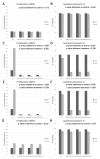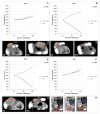Radiosensitivity of Cancer Stem Cells Has Potential Predictive Value for Individual Responses to Radiotherapy in Locally Advanced Rectal Cancer
- PMID: 33297488
- PMCID: PMC7762426
- DOI: 10.3390/cancers12123672
Radiosensitivity of Cancer Stem Cells Has Potential Predictive Value for Individual Responses to Radiotherapy in Locally Advanced Rectal Cancer
Abstract
Neo-adjuvant radiotherapy is frequently employed in the therapeutic management of locally advanced rectal cancer (LARC). Radiotherapy can both reduce local recurrence and improve the success of surgical procedures by reducing tumor mass size. However, some patients show a poor response to treatment, which results in primary resistance or relapse after apparent curative surgery. In this work, we report in vitro and in vivo models based on patient-derived cancer stem cells (CSCs); these models are able to predict individual responses to radiotherapy in LARC. CSCs isolated from colorectal cancer biopsies were subjected to in vitro irradiation with the same clinical protocol used for LARC patients. Animal models, generated by CSC xenotransplantation, were also obtained and treated with the same radiotherapy protocol. The results indicate that CSCs isolated from rectal cancer needle biopsies possess an intrinsic grade of sensitivity to treatment, which is also maintained in the animal model. Notably, the specific CSCs' in vitro and in vivo sensitivity values correspond to patients' responses to radiotherapy. This evidence suggests that an in vitro radiotherapy response predictivity assay could support clinical decisions for the management of LARC patients, thus avoiding radiation toxicity to resistant patients and reducing the treatment costs.
Keywords: cancer stem cells; in vitro radiotherapy; locally advanced rectal cancer (LARC); neo-adjuvant radiotherapy; preclinical model of radiotherapy.
Conflict of interest statement
The authors declare no conflict of interest.
Figures




Similar articles
-
Sequential FDG-PET/CT reliably predicts response of locally advanced rectal cancer to neo-adjuvant chemo-radiation therapy.Eur J Nucl Med Mol Imaging. 2007 Oct;34(10):1583-93. doi: 10.1007/s00259-007-0426-1. Epub 2007 May 15. Eur J Nucl Med Mol Imaging. 2007. PMID: 17503039 Clinical Trial.
-
XRCC2 as a predictive biomarker for radioresistance in locally advanced rectal cancer patients undergoing preoperative radiotherapy.Oncotarget. 2015 Oct 13;6(31):32193-204. doi: 10.18632/oncotarget.4975. Oncotarget. 2015. PMID: 26320178 Free PMC article.
-
Dose escalation of preoperative short-course radiotherapy followed by neoadjuvant chemotherapy in locally advanced rectal cancer: protocol for an open-label, single-centre, phase I clinical trial.BMJ Open. 2019 Mar 23;9(3):e025944. doi: 10.1136/bmjopen-2018-025944. BMJ Open. 2019. PMID: 30904869 Free PMC article.
-
An update on the multimodality of localized rectal cancer.Crit Rev Oncol Hematol. 2016 Dec;108:23-32. doi: 10.1016/j.critrevonc.2016.10.004. Epub 2016 Oct 26. Crit Rev Oncol Hematol. 2016. PMID: 27931837 Review.
-
Cancer Stem Cell Biomarkers Predictive of Radiotherapy Response in Rectal Cancer: A Systematic Review.Genes (Basel). 2021 Sep 25;12(10):1502. doi: 10.3390/genes12101502. Genes (Basel). 2021. PMID: 34680897 Free PMC article.
Cited by
-
Editorial: Bio-Pathological Markers in the Diagnosis and Therapy of Cancer.Cancers (Basel). 2023 Feb 26;15(5):1484. doi: 10.3390/cancers15051484. Cancers (Basel). 2023. PMID: 36900276 Free PMC article.
-
Wee1 Kinase: A Potential Target to Overcome Tumor Resistance to Therapy.Int J Mol Sci. 2021 Oct 1;22(19):10689. doi: 10.3390/ijms221910689. Int J Mol Sci. 2021. PMID: 34639030 Free PMC article. Review.
-
Ex Vivo Irradiation of Lung Cancer Stem Cells Identifies the Lowest Therapeutic Dose Needed for Tumor Growth Arrest and Mass Reduction In Vivo.Front Oncol. 2022 May 12;12:837400. doi: 10.3389/fonc.2022.837400. eCollection 2022. Front Oncol. 2022. PMID: 35646627 Free PMC article.
-
Impact of STAT-signaling pathway on cancer-associated fibroblasts in colorectal cancer and its role in immunosuppression.World J Gastrointest Oncol. 2024 May 15;16(5):1705-1724. doi: 10.4251/wjgo.v16.i5.1705. World J Gastrointest Oncol. 2024. PMID: 38764833 Free PMC article. Review.
-
Mathematical modeling of the synergistic interplay of radiotherapy and immunotherapy in anti-cancer treatments.Front Immunol. 2024 May 8;15:1373738. doi: 10.3389/fimmu.2024.1373738. eCollection 2024. Front Immunol. 2024. PMID: 38779678 Free PMC article.
References
-
- Fedirko V., Tramacere I., Bagnardi V., Rota M., Scotti L., Islami F., Negri E., Straif K., Romieu I., La Vecchia C., et al. Alcohol drinking and colorectal cancer risk: An overall and dose-response meta-analysis of published studies. Ann. Oncol. 2011;22:1958–1972. doi: 10.1093/annonc/mdq653. - DOI - PubMed
Grants and funding
LinkOut - more resources
Full Text Sources

